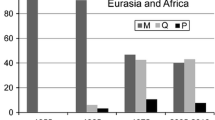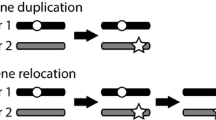Summary
We have developed an experimental system to assay conversion and reciprocal exchange between tandem repeats in Drosophila melanogaster. In this system, the recombining markers map 0.76 kb apart within the Adh gene, and the length of the repeated unit is 4.75 kb. Our results provide a preliminary record of germline frequencies of gene conversion and unequal exchange between these markers. Conversions involving dispersed repeats were not observed, and may be less frequent. This work demonstrates that conversion takes place at an appreciable frequency between tandem repeats in metazoan germline. It confirms that gene conversion can mediate homogenization of reiterated sequences in higher eukaryotes.
Similar content being viewed by others
References
Abastado JP, Cami B, Huynh Dinh T, Igolen J, Kourilsky P (1984) Processing of complex heteroduplexes in Escherichia coli and Cos-1 monkey cells. Proc Natl Acad Sci USA 81:5792–5796
Amstutz H, Munz P, Heyer WD, Leopold U, Kohl J (1985) Concerted evolution of tRNA genes: intergenic conversion among unlinked serine genes in S. pombe. Cell 40:879–886
Baltimore D (1981) Gene conversion: some implications for immunoglobulin genes. Cell 24:592–594
Benyajati C, Place AR, Sofer W (1983a) Formaldehyde mutagenesis in Drosophila. Molecular analysis of Adh-negative mutants. Mutat Res 111:1–7
Benyajati C, Spoerel N, Haymerle H, Ashburner M (1983b) The messenger RNA for alcohol dehydrogenase in Drosophila melanogaster differs in its 5′ end in different development stages. Cell 33:125–133
Borst P, Cross GAM (1982) Molecular basis for trypanosome antigenic variation. Cell 29:291–303
Borst P, Greaves DR (1987) Programmed gene rearrangements altering gene expression. Science 235:658–667
Brégégère F (1983) A directional process of gene conversion is expected to yield dynamic polymorphism associated with stability of alternative alleles. Biochimie 65:229–237
Brennan MD, Dickinson WJ (1988) Complex developmental regulation of the Drosophila affinidisjuncta alcohol dehydrogenase in Drosophila melanogaster. Dev Biol 125:64–74
Brock HW, Roberts DB (1983) Localisation of the LSP-1 genes in Drosophila species by in situ hybridization. Genetics 103:75–92
Chia W, Savakis C, Karp R, Pelham H, Ashburner M (1985) Mutation of the Adh gene of Drosophila melanogaster containing an internal tandem duplication. J Mol Biol 186:679–688
Chovnick A (1973) Gene conversion and transfer of genetic information within the inverted region of inversion heterozygotes. Genetics 75:123–131
Denaro M, Hammerling U, Rask L, Peterson PA (1984) The Eβb gene may have acted as the donor gene in a gene conversion-like event generating the Aβbm12 mutant. EMBO J 3:2029–2053
Dover G (1982) Molecular drive: a cohesive mode of species evolution. Nature 299:111–117
Fasullo MT, Davis RW (1987) Recombinational substrates designed to study recombintion between unique and repetitive sequences in vivo. Proc Natl Acad Sci USA 84:6215–6219
Feinberg AP, Vogelstein B (1984) A technique for radiolabeling DNA restriction endonuclease fragments to high specific activity. Anal Biochem 137:266–267
Gelbart WM, Chovnick A (1979) Spontaneous unequal exchange in the rosy region of Drosophila melanogaster. Genetics 92:849–859
Geyer P, Richardson KL, Corces VG, Green MM (1988) Genetic instability in Drosophila melanogaster: P-element mutagenesis by gene conversion. Proc Natl Acad Sci USA 85:6455–6459
Goldberg DA (1980) Isolation and partial characterization of the Drosophila alcohol dehydrogenase gene. Proc Natl Acad Sci USA 77:5794–5798
Hilliker AJ, Chovnick A (1981) Further observations on intragenic recombination in Drosophila melanogaster. Genet Res (Camb) 38:281–296
Jackson JA, Fink GR (1981) Gene conversion between duplicated genetic elements in yeast. Nature 292:306–311
Jinks-Robertson S, Petes TD (1985) High-frequency meiotic gene conversion between repeated genes on nonhomologous chromosomes in yeast. Proc Natl Acad Sci USA 82:3350–3354
Karess RE, Rubin GM (1984) Analysis of P transposable element functions in Drosophila. Cell 38:135–146
Klar AJS, Hicks JB, Strathern JN (1982) Directionality of yeast mating-type interconversion. Cell 28:551–561
Kourilsky P (1983) Genetic exchanges between partially homologous nucleotide sequences: possible implications for multigene families. Biochimie 65:85–93
Lim JK (1988) Intrachromosomal rearrangements mediated by hobo transposons in Drosophila melanogaster. Proc Natl Acad Sci USA 85:9153–9157
Lin FL, Sternberg N (1985) Homologous recombination between overlapping thymidine kinase gene fragments stable inserted into a mouse cell genome. Mol Cell Biol 4:852–861
Liskay RM, Stachelek JL, Letsou A (1984) Recombination between repeated chromosomal sequences in mouse cells. Cold Spring Harbor Symp Quant Biol 49:183–189
Lohe AR, Brutlag DL (1987) Adjacent DNA segments in Drosophila: structure of junctions. J Mol Biol 194:161–170
O'Donnell J, Gerace L, Leister F, Sofer W (1975) Chemical selection of mutants that affect alcohol dehydrogenase in Drosophila. II. Use of 1-pentyne-3-ol. Genetics 79:73–83
Ohta T (1984) Some models of gene conversion for treating the evolution of multigene families. Genetics 106:517–528
Pays E, van Assel S, Laurent M, Darville M, Vervoort T, van Meirvenne N, Steinert M (1983) Gene conversion as a mechanism for antigenic variation in trypanosomes. Cell 34:371–380
Pittler SJ, Salz HK, Davis RL (1987) An interchromosomal gene conversion of the Drosophila dunce locus identified with restriction site polymorphisms: a potential involvement of transposable elements in gene conversion. Mol Gen Genet 208:315–324
Posakony JW, Fischer JA, Maniatis T (1985) Identification of DNA sequences required for the regulation of Drosophila alcohol dehydrogenase gene expression. Cold Spring Harbor Symp Quant Biol 50:515–520
Reynaud CA, Anquez V, Grimal H, Weill JC (1987) A hyperconversion mechanism generates the chicken light chain preimmune repertoire. Cell 48:379–388
Rocher-Chambonnet C, Berreur P, Houde M, Tiveron MC, Lepesant JAL, Brégégère F (1987) Cloning and partial characterization of the xanthine dehydrogenase gene of Calliphora vicina, a distant relative of Drosophila melanogaster. Gene 59:201–212
Rubin GM, Spradling AC (1982) Genetic transformation of Drosophila with transposable element vectors. Science 218:348–353
Rubin GM, Spradling AC (1983) Vectors for P-element mediated gene transfer in Drosophila. Nucleic Acids Res 11:6341–6351
Saint Vincent BR de, Wahl GM (1983) Homologous recombination in mammalian cells mediates formation of a functional gene from two overlapping gene fragments. Proc Natl Acad Sci USA 80:2002–2006
Scherer S, Davis RW (1980) Recombination of dispersed repeated DNA sequences in yeast. Science 209:1380–1384
Smith AJS, Berg P (1984) Homologous recombination between defective Neo genes in mouse 3T6 cells. Cold Spring Harbor Symp Quant Biol 49:171–181
Thatcher DR (1980) The complete amino acid sequence of three alcohol dehydrogenase alleloenzymes (Adh s n11 Adh S and Adh UP) from the fruitfly Drosophila melanogaster. Biochem J 187:875–886
Vigue C, Sofer W (1976) Chemical selection of mutants that affect Adh activity in Drosophila. III. Effects of ethanol. Biochem Genet 14:127–135
Voelker RA, Schaeffer HE, Mukai T (1980) Spontaneous allozyme mutations in Drosophila melanogaster: rate of occurrence and nature of the mutants. Genetics 94:961–968
Weiss E, Mellor A, Golden L, Fahrner K, Simpson E, Hurst J, Flavell RA (1983) The structure of a mutant H-2 gene suggests that the generation of polymorphism in H-2 genes may occur by gene conversion-like events. Nature 301:671–674
Woodruff RC, Ashburner M (1979) The genetics of a small autosomal region of Drosophila melanogaster containing the structural gene for alcohol dehydrogenase. I. Characterization of deficiencies and mapping of Adh and visible mutations. Genetics 92:117–132
Author information
Authors and Affiliations
Additional information
Communicated by D.J. Finnegan
Rights and permissions
About this article
Cite this article
Hipeau-Jacquotte, R., Brutlag, D.L. & Brégégère, F. Conversion and reciprocal exchange between tandem repeats in Drosophila melanogaster . Molec. Gen. Genet. 220, 140–146 (1989). https://doi.org/10.1007/BF00260868
Received:
Issue Date:
DOI: https://doi.org/10.1007/BF00260868




